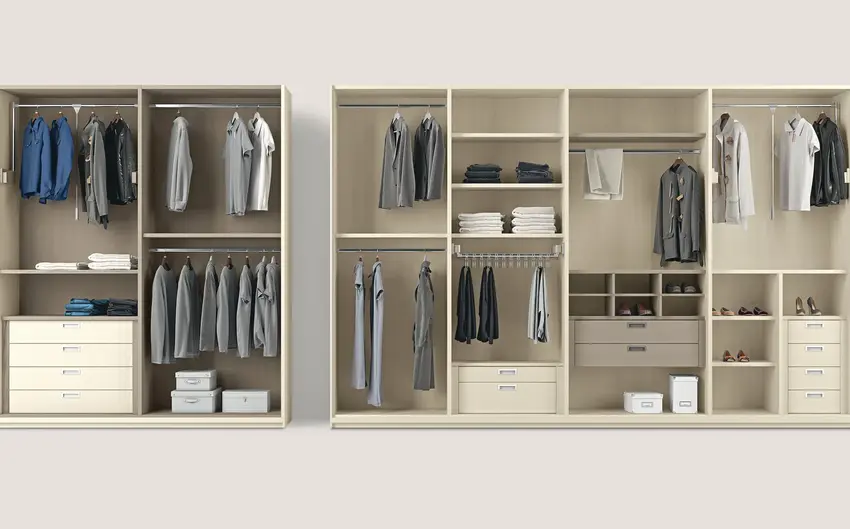Closets are the unsung heroes of interior design. They hold our treasures, keep our spaces tidy, and add a touch of organisation to our lives. Rooms commonly have closets, including bedrooms, entryways, and sometimes even living rooms or home offices. However, there are creative ways to add storage for spaces without traditional closets, such as utilising freestanding wardrobes, modular shelving units, under-bed storage containers, or hanging organizers.
The history of closets and their significance in interior design

Closets have been around for centuries, dating back to ancient times. Over time, closets evolved into essential home features, shaping how spaces are organised and utilised.
In the 18th century, closets became more common in households, and furniture designed specifically for storing clothing and personal items rose in popularity. Fast-forward to today, and closets are a staple in modern interior design, offering both functionality and aesthetics to living spaces.
The significance of closets in interior design cannot be overstated. They provide practical storage solutions and contribute to a room’s overall look and feel. Each type, from walk-in closets to reach-in ones, uniquely maximizes space efficiency and enhances room organisation.
Types of closets – walk-in, reach-in, wardrobe, etc
There are many types to choose from based on your needs and space. The walk-in closet is a dream for many, offering ample room to organize clothes and accessories. It’s like having your mini boutique right at home.
Closets are more compact but still provide practical storage solutions for smaller spaces. They typically have one or two doors open outward, allowing easy access to your belongings.
Wardrobes are freestanding pieces of furniture that can replace built-in closets. They come in various styles and sizes, making them versatile options for different rooms in the house.
Rooms that commonly have closets and why

Bedrooms are at the top of the list of rooms that commonly have closets. Bedrooms typically include closets for storing clothing, shoes, and accessories to keep the space organised and clutter-free.
Closets in bedrooms serve as functional storage solutions while also adding value to the room’s design and layout. They provide a dedicated space for hanging clothes, folding garments, and keeping personal items neatly tucked away.
Walk-in closets are often found in master bedrooms, offering ample storage space with shelves, drawers, and racks for optimal organisation. Reach-in closets are more common in smaller bedrooms but provide essential storage capabilities.
Bedrooms, entryways, and mudrooms frequently feature reach-in or walk-in closets to store coats, hats, and shoes conveniently near the main entrance of a home. These closets help maintain tidiness by preventing outdoor gear from being scattered throughout living spaces.
Alternatives to traditional closets in rooms without them
When faced with a room that lacks a traditional closet, there are various creative alternatives to explore. One option is to utilize freestanding wardrobes or armoires, which provide storage space and add a touch of style to the room. These pieces can be customised to fit the space’s aesthetic while offering ample storage for clothing and accessories.
Another alternative is incorporating open shelving units or garment racks into the room design. This allows for easy access to items without needing a closed-off closet. Organising clothing and shoes on display can create a visually appealing feature while keeping everything within reach.
Vertical storage solutions like wall-mounted shelves or hanging organizers can maximize storage capacity for rooms with limited floor space without taking up valuable square footage. These options are versatile and adaptable to different room layouts and sizes.
Exploring unconventional storage solutions such as under-bed drawers, ottomans with hidden compartments, or even utilizing unused corners for built-in shelving can further optimize organisation in rooms lacking closets. The key is thinking outside the box and getting creative with how storage solutions are integrated into the room’s overall design.
Creative ways to add storage space in rooms without closets
I am installing floating wall shelves to store books, decor, and other items. For extra organisation and hidden storage, organisational, use baskets or bins under the bed.
Opt for furniture that offers hidden compartments, such as coffee tables with lift-up tops or benches with storage underneath the seat. Think outside the box when adding storage in rooms lacking closets!
Conclusion:
When designing a room, it’s essential to consider the importance of closet space. Closets not only provide storage solutions but also contribute to the overall aesthetics and functionality of a space. Whether it’s a walk-in closet, reach-in closet, wardrobe, or other storage alternatives, having dedicated storage areas can help organize and clutter-free maximising available space and implement smart storage solutions tailored to each room’s needs. You can enhance the practicality and visual appeal of your living environment.




